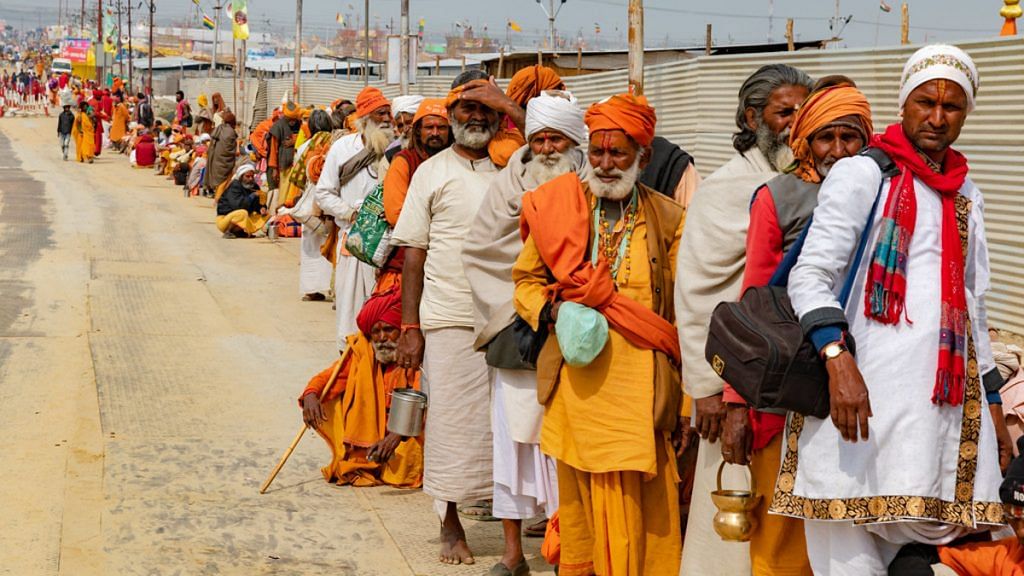New Delhi: Two Hindu ascetics, who were lynched along with their driver by a mob in Maharashtra’s Palghar district last week, were affiliated to Shri Panch Dashnam Juna Akhara in Varanasi.
On Monday, Prem Giri Maharaj, the international president of Juna Akhara said sadhus from across the country would gather in Nashik after the lockdown is lifted to demand a probe into the lynching, and march all the way to Mumbai to make their demands of Maharashtra Chief Minister Uddhav Thackeray.
The CM has, however, already announced a probe into the case. Over 100 people have also been arrested for the same.
The incident, which has created a massive political row, took place when a group of villagers stopped the men while they were on their way to a funeral in Silvassa and attacked them with stones, logs and axes.
The sadhus – 70-year-old Kalpvrush Giri and 35-year-old Sushil Giri – belonged to the Gosavi nomadic tribe.
As the case acquires a political colour amid communal allegations, ThePrint takes a look at Juna Akhara, its history and membership.
Also read: No communal angle to Palghar, strict action against those fuelling hate: Uddhav Thackeray
What is an Akhara?
Hinduism philosopher Adi Shankaracharya believed the understanding of religion could only be spread through worship. Around the time when India was invaded by foreigners in the eight century, he inspired his followers to study weaponry because he believed it strengthens the mind.
This created the concept of an akhara. Traditionally, akharas are known as wrestling pits but through Shankaracharya’s teachings they came to be seen as the centre of debates and religious discussions.
Shankaracharya established 7 akharas in 722 AD – namely, Mahanirvani, Niranjani, Juna, Atal, Aavahana, Agni and Anand.
The number of these akharas later increased to 13.
Juna Akhara
Shree Panch Dashnam Juna Akhara’s headquarters are in Varanasi, Uttar Pradesh. Out of the 13 akhadas which participate in the Kumbh Mela, Juna, meaning old in Gujarati, is the largest.
There are over 4,00,000 ascetics in this akhara. It is Shaivite body, which means its members are followers of Lord Shiva. This akhara is attached to the four mutts established by Shankaracharya at Dwarka, Puri, Sringeri and Jyotirmath.
Juna Akhara is a traditional body wherein families of 52 lineages are represented by their elders in a grand council, which is in turn represented by elected secretaries and a sabhapati (president). When someone is elected to a position, their appointment stands for life.
All matters concerning the council are divided into two categories, samaj (dealing with society) and ghar (concerning the sadhu families).
The council members are all Naga sadhus (warrior ascetics) who are appointed during the Kumbh and Mahakumbh Mela.
Swami Avdheshanand Giri Ji Maharaj is Juna Akhara’s current Acharya Mahamandaleshwar – the chief religious authority. He was appointed in 1998.
On Monday, he condemned the Palghar lynching incident and tweeted, “The brutal violence against Juna Akhara Sadhus in Palghar is shocking and highly condemnable. Strict action must be taken to address this inhuman act.”
The brutal violence against Juna Akhara Sadhus in Palghar is shocking and highly condemnable. Strict action must be taken to address this inhuman act. #PalgharLobbySilence #पालघर_माॅंवलिंचिंग @ArnabGoswamiRtv @republic @ani_digital @OfficeofUT #एकांतऔषधिहै #घरमेंरहेंस्वस्थरहें
— Swami Avdheshanand (@AvdheshanandG) April 20, 2020
The sannyasi tradition is rooted in the welfare of humanity ; they are ambassadors of our spiritual heritage. It is the duty of mankind to safeguard their dignity.#PalagharLynchingtruth #एकांतऔषधिहै #घरमेंरहेंस्वस्थरहें #WorldHeritageDay #BeatCOVID19 #StayAtHome #ArnabGoswami
— Swami Avdheshanand (@AvdheshanandG) April 21, 2020
Also read: Most Muslims in Punjab’s Malerkotla have Tablighi link. But that’s not their big Covid worry
